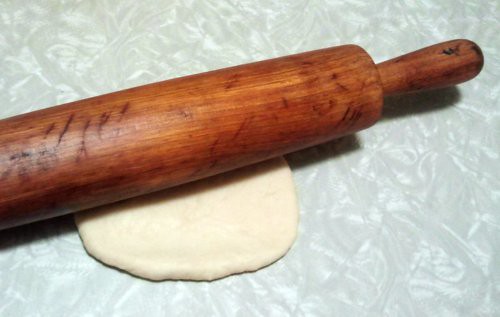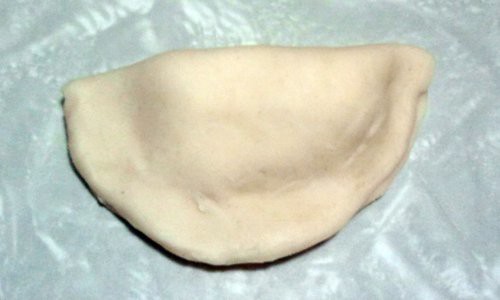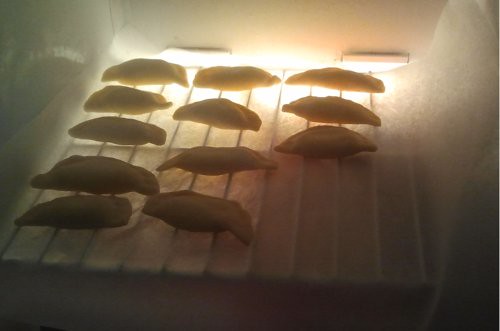Back in the late 1980's, after I had been thoroughly adopted into my wife's family, her grandaunt Nellie handed me a small bundle of papers. "These are the family recipes," she told me. "I didn't want to give them to just anybody, but I know you'll make them so now they're yours."
I've made them many times since then, and I shared the recipe with my friends on the old Fidonet National Cooking Echo, an electronic message forum that predates the internet, in 1997. Apparently, a lot of other people liked her recipe too, gathered into a large number of internet databases, freeware electronic cookbooks, and so on (often with my byline and attribution stripped out.)
Aunt Nellie's pierogis were always a family favorite. She had learned how to make them from her mother, who had never written any recipes down on paper. Nellie, however, took notes so she wouldn't miss anything - especially with the dough. She said that making the fillings was easy, but making the dough depended almost as much on "feel" as it did ingredients. The first time I made pierogies, she sat with me at the kitchen table and walked me through it. We made three batches of dough before it measured up to her standards.
It's hard to describe the proper texture of the dough. It should be almost silky to the fingertips, soft and yielding, yet firm and somewhat elastic - similar to egg noodle dough but not as dry. It's very much like the dough for scallion pancakes, which was once described to me this way: "It should feel like a young girl's arm."
Anyway, I'm going to get right to the recipes. This is going to be a long post.
Auntie Nellie's Pierogi DoughEnough for 24-30 old-style small pierogi
2 cups sifted flour1 large egg1/2 cup warm water1 teaspoon salt2 tablespoons butter, melted
Mix all ingredients lightly and knead in the bowl.
Rest for an hour, covered. Then turn out onto a floured board and knead again until smooth. The dough should be silky, firm and elastic.
Roll out dough about 1/8-inch thick. I don't roll out the entire batch at once, but only enough for three or four pierogi. You can gather up scrpas, knead them briefly, and then roll them again - it won't make the dough tough.
Cut out circles with a coffee cup or medium biscuit cutter. (Use a large biscuit cutter if you want pierogies the size of the ones you buy in the store these days. The coffee cup/medium biscuit cutter method produces the same kind of smaller pierogies that were common up through the 1950s.)
Put a small amount of your choice of filling in the center of each of the circles - about a teaspoon or so will be plenty - and then fold the circle in half with the filling in the center.
Firmly pinch the outside edges together to seal the pierogi - they need to be well-sealed to keep them from opening up when you cook them.
To cook: bring a pot of water up to a full rolling boil and drop the pierogi in. Turn the heat down a bit to a low boil to prevent them from opening back up. Cook them for a few minutes after they rise to the top of the pot and float. Serve with melted or browned butter, or you can saute them in a little butter with some sliced onions until they are slightly browned.
If you're making them way ahead of time - say, during Lent for eating at Easter breakfast - place them, separated, on a rack or a cookie sheet in your freezer. They'll be frozen solid in about an hour, and then you can tip them into a plastic bag and pop them back into the freezer for longer-term storage. Tip: Don't bag them before they are completely frozen, or they will stick together into an impossible-to-separate mass.
Okay, now you have a recipe for the dough and how to fill and cook them. We'll follow up with a few recipes for fillings. Over the years I've made a few adaptations; her original recipes were drastically underseasoned, and the quantity yield was strange - some filling recipes would make just the right amount for a single batch of dough and some would make insanely huge quantities that required three or four batches of dough to use up. The recipes I'm giving here are still hers, they're just tweaked a little, and more accurately sized for a single batch of dough.
This mushroom filling is one of my family's favorites. Auntie Nellie always made it with plain white mushrooms, but she told me that her grandparents used wild prawdziwek mushrooms from the forest (I found out later that prawdziwek is the Polish name for porcini shrooms, or cèpes. Unfortunately, cèpes are very rarely available fresh here in the US, so I try to use a mix of white, shiitake, and oyster mushrooms for a richer flavor. Occasionally, I find cèpes canned in oil in the local Russian market. Not only are they awesome for stuff like this filling, but the oil is hugely flavorful for other culinary uses.
This cheese filling is Lynnafred's favorite. Even though it's as much mashed potato as it is cheese, the filling becomes kind of "fluffy" and creamy when it cooks, kind of like the ricotta layer in a lasagna.
This mushroom filling is one of my family's favorites. Auntie Nellie always made it with plain white mushrooms, but she told me that her grandparents used wild prawdziwek mushrooms from the forest (I found out later that prawdziwek is the Polish name for porcini shrooms, or cèpes. Unfortunately, cèpes are very rarely available fresh here in the US, so I try to use a mix of white, shiitake, and oyster mushrooms for a richer flavor. Occasionally, I find cèpes canned in oil in the local Russian market. Not only are they awesome for stuff like this filling, but the oil is hugely flavorful for other culinary uses.
Auntie Nellie's Mushroom Pierogi Filling
Enough for one batch of Aunt Nellie's dough
Butter
1 medium onion, finely minced
1 cup mushrooms, finely minced
Celery salt and freshly ground black pepper to taste
2 large egg yolks
Melt butter (a couple of tablespoons to start) in a pan and saute onion until translucent and amber. Add the mushrooms and continue to cook until mushrooms are done. (Onions and mushrooms both take up the butter as they cook, so feel free to add more butter to the pan as you wish.)
Remove the pan from the fire and add seasonings to taste. Add egg yolks and stir in well.
Allow to cool before filling pierogi.
This cheese filling is Lynnafred's favorite. Even though it's as much mashed potato as it is cheese, the filling becomes kind of "fluffy" and creamy when it cooks, kind of like the ricotta layer in a lasagna.
Auntie Nellie's Cheese Pierogi Filling
Enough for one batch of Aunt Nellie's dough
1½ cups Farmer's Cheese1 cup mashed potatoes (leftover is OK, instant is not.)Celery salt and freshly ground black pepper to taste½ teaspoon dried summer savory (optional)
In a bowl, whisk the farmer's cheese until light. Add mashed potato and seasonings and stir thoroughly until combined. Taste and adjust seasoning as needed before filling pierogi.
No matter how many varieties of pierogi I make for holidays, I have to make at least as much of the cabbage-filled ones as I do of all the others combined. As much as everyone likes the mushroom and cheese pierogis, they seem to like the cabbage ones best of all. And it's a very flexible recipe as well. It takes well to doubling or more, and it adapts well to other additions - Auntie Nellie would often make it with a couple of mashed potatoes added, or with a few finely-chopped mushrooms in the mix to liven up the flavor. Originally, the recipe called for the sauerkraut to be simmered with the cabbage three times, changing the water between each parboiling. While that certainly made the cabbage tender, it also tended to draw off every bit of flavor from the sauerkraut. I think the flavor is much better with a bit of the sauerkraut tang remaining, so I've eleminated two of the parboilings. Feel free to add them back if you desire.
Auntie Nellie's Cabbage Pierogi FillingApproximately Enough for one batch of Aunt Nellie's dough1½ cups sauerkraut1½ cups finely shredded fresh cabbage3 tablespoons butter1 small onion, finely mincedDash or two of Maggi SeasoningCelery Salt to tasteFreshly ground black pepper to taste (see instructions)
Parboil the sauerkraut and cabbage in water to cover, simmering until the cabbage is tender. Pour off the water and finely chop the cabbage mixture.
Melt butter in a skillet and add the onion. Cook until the onion is amber and translucent, then add a shake or two of Maggi along with the cabbage mixture and saute until the cabbage just starts to brown a bit. Season with celery salt and black pepper. I usually use a heavy hand with the pepper because the cabbage mix takes well to the fruity aroma and spicy kick of robust black pepper seasoning. Allow to cool completely before filling pierogi.
Enjoy!





AFAIK you are *still* the moderator of the FIDO Cooking Echo. Your presence has been missed.
ReplyDeleteIn this case - you CAN go home again.
I realize it probably does not make any difference, and that real chefs will chuckle at my question, but there is a myriad of egg sizes now available.
ReplyDeleteWhat size would Aunt Nellie have chosen?
Tom
Great set of recipes. So nice that you chose to share these. Now Aunt Nellie's recipes can be enjoyed by the world, or at least by Dave's Cupboard world to start with.
ReplyDeleteI love the family traditions surrounding pierogi. We are a farmer's cheese/egg/seasonings family, but I will have to try the mushroom recipe.
ReplyDeleteNice to see the FARMER cheese filling. So many people settle for mashed potatoes, which, to me, isn't authentic.
ReplyDeleteTomW - In recipes where egg size is not specified, large eggs are standard. But you're right, I shouldn't just assume that everyone knows that, so I've edited the recipes to specify the size.
ReplyDeleteHuge dork here... but I just got these pierogi tupperware makers... Just little plastic things that you put the dough on, then the filling, close... crimped and ready to go... Anyways; I have been seeking a recipe to do, and the cabbage one sounds just like my great great aunt (German descent) use to make when I was younger. Thanks for sharing Dave!
ReplyDeleteYeah... So I made the the potato filling... Added ricotta instead of farmer's cheese. Also added chopped green onions and bacon. Pan fried in butter... Delicious.
ReplyDeleteThe great thing about a baseline recipe like pierogi filling is the flexibility. Glad you came up a variation you enjoy.
ReplyDelete